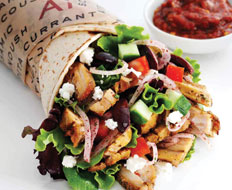Appeasing the nation’s growing taste for Mediterranean and healthy-but-delicious meals, and doing so in a quick-serve format, has proved a winning combination for Roti Mediterranean Grill.
“We explored what was available around the country in this type of food,” says Bill Post, Roti cofounder and CEO. “We observed that most Middle Eastern restaurants had table service. So while the popularity of the Mediterranean diet had grown, it had not been popularized in quick service. So we saw a real window of opportunity.”
The first Roti opened in Chicago in 2007, and the chain has since grown to 13 units around the Windy City and Washington, D.C.
The concept adopted a build-your-own-meal, assembly-line method of ordering, similar to Chipotle’s. Customers first choose among building a sandwich, a salad, or a rice-based plate. A sandwich can be made with pita or laffa bread, which is a wrap. A protein is chosen next; both chicken and beef are cooked on vertical rotisseries at Roti. Those wanting a vegetarian meal can opt for falafel or roasted vegetables.
Customers can then choose up to three toppings, which include mixed greens, onions sprinkled with a Middle Eastern spice called sumac, tomato and cucumber salad, couscous, red cabbage slaw, baba ghanouj, and hummus. Finally, there are sauce options, including the mild Dill, Yogurt & Cucumber, or Tahini options; a medium Red Pepper Aioli; or the hot, spicy S’hug sauce.
Diners who prefer leaving culinary decisions to the experts can choose from the menu’s list of Favorites, including the Sultan Sandwich, made with chicken, hummus, and tomato and cucumber salad in a house-baked pita with S’hug sauce; the Double Chicken Kabob Plate, with two grilled skewers of chicken breast served with rice, tomato and cucumber salad, choice of sauce, and a pita; or Mediterranean Chopped Chicken Salad, with mixed greens, chicken, tomato and cucumber salad, feta cheese, kalamata olives, cous-cous, and pita croutons with vinaigrette dressing and a pita.
Post says one of the staple ingredients that makes Roti recipes healthier than traditional fast food is olive oil. “It’s one of the healthiest oils because it’s low in saturated fat,” he says.
The roasted vegetables at Roti are tossed in the heart-healthy oil before cooking and the Spanish eggplant, a topping choice, is sautéed in olive oil.
Roti Mediterranean Grill
CEO: Bill Post
HQ: Chicago
Year Started: 2007
Annual Sales: $1.5 million per unit
Total Units: 13
Franchise Units: 0
Roti offers dine-in and delivery services, as well as a catering menu. Post says an average per-person dine-in ticket is $8.50–$9, though suburban stores land closer to $10 because they tend to do more business at dinnertime. Four new Roti locations are planned for the Chicago area in 2012, and Post says the company also has leases for stores in New York City.
“While three additional markets are being developed and expanded, we are not eager beavers to grow by going to one city at a time and opening just one or two stores,” he says. “We want to develop into significant numbers in each market we are in.”
Post says that by the end of 2012, Roti will have 18–20 stores open. All will be company owned.
“We have no plans for franchising right now,” he says. “We have way too many things we need to refine before we’d let control out of our hands.”
Post says he gets as many as 10 calls a day about franchising, however.
“What happens at Roti is that during peak lunch times we get very long queue lines,” he says. “People look at that and think we must be doing something right, and that prompts a lot of inquiries.”
Post says a Roti store is designed to accommodate 60–80 people waiting in line, and typically a guest can get through a 70-person line in 7–8 minutes.
“We make the wait seem shorter by doing a lot of sampling and recognizing new customers and talking with them so they don’t feel pressure when they get up there to order,” Post says.
Some Roti locations are open for lunch and dinner seven days a week. Others are only open for breakfast, lunch, and a short dinner period, while a few are not open for dinner at all. Post says it depends on location when the store is open. For example, a small Roti unit in a train station in Washington, D.C., does well at breakfast, serving pita bread sandwiches with eggs and other breakfast fare. Because it is near government office buildings filled with people hurrying to work each weekday morning, he calls this location a “pocket of opportunity for breakfast.” That same opportunity does not exist for suburban locations.
“Breakfast is a very hard category,” he says. “It’s hard to break people’s habits when it comes to breakfast.”
Post says a typical Roti is about 2,250 square feet, but the 13 existing stores run the gamut from a small kiosk in a food court to 4,000 square feet. All Roti stores have Mediterranean décor, with interior stone and tile.
“We use field stone because you see a lot of that in the Mediterranean, along with a lot of wood and tile,” Post says. “We use a lot of cracked or chipped tile to give it an authentic look.”
One Chicago Roti location has earned a two-star certification from the Green Restaurant Association, and Post says that as the concept grows he would like to add to its “green accolades.”








